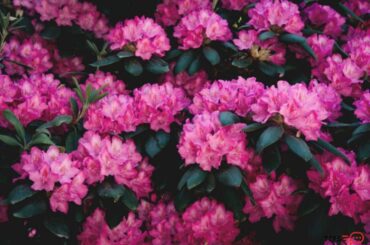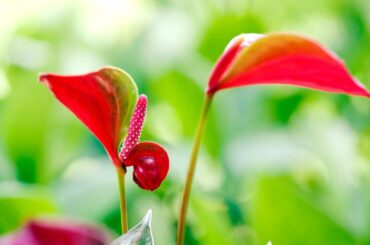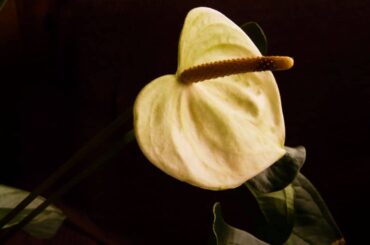I’m pretty sure that when you hear the name ‘’anthurium,’’ a plant with bright red shiny flowers is pictured in your mind. So, you’ll be really frustrated to see your anthuriums fading to green, yellow, white, or brown. So Why do anthurium flowers turn green? In here flower means spathe. Many people confused spathe as the anthurium flower.
Usually, color changes are not rare in anthuriums. If you see your anthuriums changing their colors, possibly there is an issue with them. Read this article to learn more about anthurium difficulties and how to overcome them.

Anthuriums are magnificent charming beauties that are a must-character for any home garden. These tropical flowering plants comprise 1,000 species in the plant family of Araceae. Anthuriums captivate us with their vibrant character, ability to produce long-lasting, attractive blooms, and ease of cultivation.
The plants produce a flower-like spathe with a spadix. This spathe is apparent in many colors, giving a vivid nature to anthurium plants. Originally, anthurium spathes were found in red, pink, and yellow, but now more colors have been introduced. You can see spathes with a wide spectrum of colors such as white, green, bright purple, magenta, orange, and so on.
The large, vivid, glossy part of the anthurium bloom is called the spathe. It is actually a modified leaf. In the middle of the spathe, there is an elongated spike-like part that is called the spadix. Often, we used to consider spathe along with the spadix as the anthurium flower, but actually, the true anthurium flowers are the tiny nubs that overlay the spadix.
Why are my Anthurium flowers turning green?
In some situations, you may have seen anthuriums fade their colors to green. If you want to find the reasons for turning your anthurium flowers green, the best way to commence is by checking the species. Shifting the flowers to green may simply be the species. Anthuriums called Midori produce flowers with bright green spathes.
Certain anthurium varieties’ flowers eventually turn green, which is a completely different color than their original color. For example, the variety known as Centennial gives flowers with a white spathe at the beginning and gradually turns to bright green. Hookeri and Clarinavium are other anthurium varieties that turn green with time. A bi-colored anthurium variety called Obke has pink spathes mixed with green.
Obviously, the color of the spathe can be changed with the age of the flower. If the appropriate conditions are provided for the plant to grow, the plant will produce flowers that last at least a month. As the flower ages, due to the degradation of color pigments, the spathe starts losing its color and it will gradually become pale.
Apart from the variety and aging, cultivation practices which include irrigation, fertilizer application, and exposure to inappropriate light and temperature also relate to the abnormal coloration of anthurium flowers. Anthurium flowers fade to green when they do not receive enough light.
Usually, anthuriums are grown under a shade as they do not prefer direct sunlight, but if the ambient light intensity is too low, the plants will respond by giving green flowers. Perhaps, you may have experienced the color fading of flowers that you’ve recently bought from a greenhouse.
Usually, greenhouses use hormones to force plants to bloom early. Once you bring these plants into the home, they won’t be exposed to such hormones any longer. For this reason, fading the color of anthurium flowers is possible. There is another possibility of turning the flowers green due to inappropriate fertilizer application. Excess nitrogen for plants also leads to the bloom color shifting to green.

Anthurium flowers turn brown
The flowers can turn brown when the plant is suffering from nutrient deficiency. When compared with novel plants, the browning of flowers is often seen in older plants. Anthurium needs a phosphorus-rich diet for healthy growth as well as for blooming. Without enough nutrients especially, phosphorus, the flowers will not be fully developed.
Therefore, it is important to treat the plant with manure that has sufficient phosphorus content. Take care when applying fertilizer to your plants. It is better to apply phosphorus-rich fertilizer to the plant at least once a month. If the plant is unable to satisfy its nutrient needs, the flowers will turn brown. If you notice brown flower anthuriums in your garden, that may indicate you are overwatering the plants.
The disease called root rot results from excessive levels of moisture on the plant. When you keep overwatering the plants, the soil becomes too damp, encouraging the pathogens such as bacteria and fungi to grow. Flowers will switch their color to brown due to the activity of these pathogens on the plant.
The brown flowers of anthurium commonly result from too much sun. Indirect light is preferable for anthuriums. If you expose the plant to direct sunlight, the flowers will be burned and become brown. Another possibility of shifting the flowers to brown is bad soil. the soil that you use for anthuriums should have the desired acidity level and it should promote aeration. Unless you use soil that permits good aeration, it will be harder for the plants to absorb nutrients.
Anthurium flowers turn yellow
Anthurium flowers shift their colors to yellow in response to temperature stress, overwatering, low humidity, excessive light, poor soil quality, and lack of fertilizer. If anthuriums turn yellow, it may indicate you are overwatering your anthurium plants. Basically, for healthy growth, anthuriums need the soil to stay moist.
However, it will create a mess if the soil is soggy constantly. When you continue to exceed the healthy water requirement of the plants, turning flowers to yellow is unavoidable. How overwatering causes flowers to yellow? When the soil becomes soggy it impairs aeration and nutrient absorption. Excessive moisture also promotes bacteria and fungi infections that can lead to color changes in flowers.
Even temperature can also contribute to changing the color of flowers. Anthuriums are tropical plants. So, they are adapted to tropical climates. But higher temperatures can damage the plant. At higher temperatures (over 32oC) the plants will be unnecessarily stressed.
This can cause the switching of the colors of anthurium flowers to yellow or green. Therefore, it is advisable to keep your anthurium plants away from heaters or any other machines that generate heat.
Anthurium flower turn white
The prime causes of the flowers turning white are exposing the plant to harsh sunlight and warm temperatures. As mentioned earlier, higher temperatures and excess light bleach color pigments that are present in spathes, turning the flowers white. At higher temperatures, plants become unhappy. In general, the optimum growing temperature for anthurium lies between 25 and 32 oC.
When the temperature is above 32 oC (90 oF), flowers start to wash off their colors and turn white. You should try to keep the temperature steady for your plants in order to obtain bright, shiny blooms. Exposure of flowers to direct sunlight also leads to bleaching their colors.
It will be pointless if you spot the anthurium in a direct sunbeam, though you maintain the proper ambient temperature for the plant. The flowers will lose their color and turn white.

Why are my anthurium flowers deformed?
Small flowers, crooked stems, deformed spathes, and deformed spadix are the most common signs of flower deformation. Why are anthuriums deformed? The foremost factors that cause deformed flowers are improper light, nutrient deficiency, and irrigation practices. If the plant is unmasked for such conditions for a prolonged time, the occurrence of small or misshapen flowers is not unusual.
The plant will bloom with smaller flowers than usual and also with crooked stems if the plant is grown under heavy shade. If your plant is indoors, it will be quite tricky to give it enough light unless you spot it near a window. Too much light also causes small flowers. Flower deformation is possible with insufficient nutrients for the plants.
Like many other plants, nitrogen, phosphorus, potassium, sulfur, magnesium, and calcium are vital nutrients for the growth and development of anthuriums. You might see distortions in the flowers due to the lack of these nutrients for the plant. Insufficient supply of nutrients impairs the development of flowers in the initial stages, leading to blooming flowers with misshapen spathes. On the other hand, the use of too much nitrogen feedings causes flowers with crooked stems.
How do you keep anthurium flowers red?
For the vivid and glossy blooms, it is essential to ensure an optimal habitat for your anthurium plants. Anthuriums should be kept in the shade where the temperature is properly controlled. Plants crave medium-light to bloom. If the plant is inside the house, bring it near a sunny window where it will gain substantial light intensity. Never unveil the plant to the direct sunlight as this causes the brilliant color of the blooms to fade.
Water as much as the plant needs. If the plant is potted, ensure proper drainage. The formation of color pigment can be reduced by too much watering. Less watering of the plants also causes the flowers to switch their colors. You should not forget to use fertilizers properly. Fertilize the plant with phosphorus-rich manure once a month. Avoid excessive use of manure as it can harm your plants.
How do you take care of anthurium flowers?
Anthuriums, magnificent beauties, are easy to grow, but if you just let them grow without care, it will be tedious work for you to have gorgeous flowers with them. You should provide optimal conditions to be certain; temperature, light, humidity, soil, water, nutrients, transplanting, and pruning for a healthy plant with rich red blooms.
Soil condition
Plant your anthuriums in well-draining soil. It will be better if the soil is acidic or has a lower pH value. The acidity of the soil is crucial for the absorption of several nutrients. For anthuriums, the optimal pH for the soil lies between 5 and 6. At higher pH, phosphorus absorption will be difficult. Anyway, you should avoid extreme acidic conditions (too low pH levels) as it can hurt the plant.
It is ideal to mix something porous and coarse, such as coco coir, or coco husk pieces into the soil. That will help proper aeration and hold enough water in the soil.
Irrigation methods
Watering your anthuriums correctly may be a quite difficult task. Anthuriums love moist soil. However, if you let the soil become soggy, it can make the plant unhealthy. So, never over-water your anthuriums. Avoid standing water inside your anthurium pot. Ensure the pot has good drainage.
Other than promoting optimal plant growth, the benefits of watering plants up to sufficient levels are: facilitating aeration, minimizing color changes in the foliage and flowers, and preventing microbial infection outbreaks such as root rot. Before you irrigate the plant, do not forget to check the moisture level of the soil.
Just dip your finger 1 to 2 inches deep into the soil and feel the dampness inside. If the soil is wet, you should not water your plants. Keep in mind that the water requirement of anthuriums varies depending on climate change. Plants need relatively much water during the summer. Due to the high temperatures during the summer, water is removed via evaporation from the soil and transpiration from the leaves at higher rates.
The plants will become dehydrated unless you water them adequately. Possibly, you can water the plants about once a week in the summer. But, during the winter, when the plant growth is slow and there is high humidity in the environment, anthuriums need less water. So, it is advisable to water about once every two weeks.

Humidity
Anthuriums prefer high humidity levels. If the ambient humidity is low, the plant may show up with tiny brown leaf tips. If you grow the plant indoors, you should carefully monitor the humidity level of the environment in which it grows. You can use a humidifier or humidity tray when the ambient condition is dry. This will help increase the relative humidity in the plant surrounding.
Temperature
Try to maintain the temperature around 25 to 32oC. If you can remember, high temperatures cause fading of the color of anthurium blooms. Therefore, keep your anthuriums away from heaters, air conditioning units, or any other forms of radiators.
Light
Anthuriums love to grow under medium to low light conditions. Therefore, anthuriums are often grown under a shade. Never expose your plants to direct sunlight. If you have anthuriums indoors, keep them near a window so they can receive enough light.
Fertilizers
In order to optimize the growth and promote blooming, it is important to fertilize your anthuriums. In general, the application of fertilizer once a month is recommended. When you select a fertilizer for anthuriums, make sure to go for a water-soluble, phosphorus-rich product.
Phosphorus promotes blooming. So, it is important to have manure with high phosphorus content for your anthuriums. You should never over-fertilize your anthuriums, especially with nitrogen. Follow the directions stated on the product label whenever you’re using fertilizers. If it is not specifically mentioned on the label, apply 1/2 or 1/4 of the fertilizer dose to your indoor anthuriums.
Repotting
It is good to repot anthuriums about every 2 to 3 years. Use a slightly larger pot than the previous and fresh potting mix when repotting. This promotes the healthy growth of the plant.
Pruning and trimming
Sometimes crooked stems of the flowers resulted from a lack of pruning. Regularly remove old, dead, distorted, and damaged leaves and flowers from the base of the plant. Use a clean sharp blade for cutting. With pruning, plants can concentrate energy and nutrients to use for blooming, colorful flowers.
To summarize, cultural practices and growing conditions have a significant impact on the preservation of anthurium flower color. Getting magnificent, beautiful blooms from your anthurium plants is not impossible if you properly offer the right environment for them.
Read Next : How To Treat Orchid Virus ?





